YAG Lasers
Definition: lasers based on YAG (yttrium aluminum garnet) crystals, usually Nd:YAG or Yb:YAG
German: YAG-Laser
Categories: optical materials, lasers
How to cite the article; suggest additional literature
Author: Dr. Rüdiger Paschotta
The term YAG laser is usually used for solid-state lasers based on neodymium-doped YAG (Nd:YAG, more precisely Nd3+:YAG), although there are other rare-earth-doped YAG crystals, e.g. with ytterbium, erbium, thulium or holmium doping (see below). YAG is the acronym for yttrium aluminum garnet (Y3Al5O12), a synthetic crystal material which became popular in the form of laser crystals in the 1960s. Yttrium ions in YAG can be replaced with laser-active rare earth ions without strongly affecting the lattice structure, because these ions have a similar size.
YAG is a host medium with favorable properties, particularly for high-power lasers and Q-switched lasers emitting at 1064 nm.
YAG lasers are in many cases bulk lasers made from discrete optical elements. However, there are also monolithic YAG lasers, e.g. microchip lasers and nonplanar ring oscillators.
The most popular alternatives to Nd:YAG among the neodymium-doped gain media are Nd:YVO4 and Nd:YLF. Nd:YAG lasers nowadays also have to compete with Yb:YAG lasers (see below).
Properties of Nd:YAG
Nd3+:YAG is a four-level gain medium (except for the 946-nm transition as discussed below), offering substantial laser gain even for moderate excitation levels and pump intensities. The gain bandwidth is relatively small, but this allows for a high gain efficiency and thus low threshold pump power.
Nd:YAG lasers can be diode pumped or lamp pumped. Lamp pumping is possible due to the broadband pump absorption mainly in the 800-nm region and the four-level characteristics.
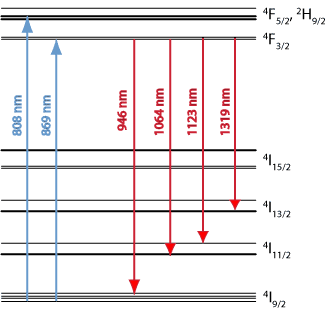
The most common Nd:YAG emission wavelength is 1064 nm. Starting with that wavelength, outputs at 532, 355 and 266 nm can be generated by frequency doubling, frequency tripling and frequency quadrupling, respectively. Other emission lines are at 946, 1123, 1319, 1338, 1415 and 1444 nm. When used at the 946-nm transition, Nd:YAG is a quasi-three-level gain medium, requiring significantly higher pump intensities. All other transitions are four-level transitions. Some of these, such as the one at 1123 nm, are very weak, so that efficient laser operation on these wavelengths is difficult to obtain:
- Even a moderate gain requires a high excitation density, which favors detrimental quenching effects.
- In addition, lasing at 1064 nm, the wavelength with much higher gain, has to be suppressed, for example by using suitable dichroic mirrors for building the laser resonator.
However, with careful optimization, even on these weak transitions one can obtain substantial output powers [4].
Nd:YAG is usually used in monocrystalline form, fabricated with the Czochralski growth method, but there is also ceramic (polycrystalline) Nd:YAG available in high quality and in large sizes. For both monocrystalline and ceramic Nd:YAG, absorption and scattering losses within the length of a laser crystal are normally negligible, even for relatively long crystals.
Typical neodymium doping concentrations are of the order of 1 at. %. High doping concentrations can be advantageous e.g. because they reduce the pump absorption length, but too high concentrations lead to quenching of the upper-state lifetime e.g. via upconversion processes. Also, the density of dissipated power can become too high in high-power lasers. Note that the neodymium doping density does not necessarily have to be the same in all parts; there are composite laser crystals with doped and undoped parts, or with parts having different doping densities.
| Property | Value |
|---|---|
| chemical formula | Y3Al5O12 |
| crystal structure | cubic |
| mass density | 4.56 g/cm3 |
| Moh hardness | 8–8.5 |
| Young's modulus | 280 GPa |
| tensile strength | 200 MPa |
| melting point | 1970 °C |
| thermal conductivity | 10–14 W / (m K) |
| thermal expansion coefficient | 7–8 · 10−6/K |
| thermal shock resistance parameter | 790 W/m |
| birefringence | none (only thermally induced) |
| refractive index at 1064 nm | 1.82 |
| temperature dependence of refractive index | 7–10 · 10−6/K |
Table 1: Some properties of YAG = yttrium aluminum garnet, which are similar for Nd- or Yb-doped YAG.
| Property | Value |
|---|---|
| Nd density for 1 at. % doping | 1.38 · 1020 cm−3 |
| fluorescence lifetime | 230 μs |
| absorption cross section at 808 nm | 7.7 · 10−20 cm2 |
| emission cross section at 946 nm | 5 · 10−20 cm2 |
| emission cross section at 1064 nm | 28 · 10−20 cm2 |
| emission cross section at 1319 nm | 9.5 · 10−20 cm2 |
| emission cross section at 1338 nm | 10 · 10−20 cm2 |
| gain bandwidth | 0.6 nm |
Table 2: Some properties of Nd:YAG = neodymium-doped yttrium aluminum garnet.
| Property | Value |
|---|---|
| Yb density for 1 at. % doping | 1.38 · 1020 cm−3 |
| fluorescence lifetime | 950 μs |
| absorption cross section at 940 nm | 0.75 · 10−20 cm2 |
| emission cross section at 1030 nm | 2.2 · 10−20 cm2 |
| absorption cross section at 1030 nm | 0.12 · 10−20 cm2 |
| emission cross section at 1050 nm | 0.3 · 10−20 cm2 |
| absorption cross section at 1050 nm | 0.01 · 10−20 cm2 |
| gain bandwidth | 15 nm |
Table 3: Some properties of Yb:YAG = ytterbium-doped yttrium aluminum garnet.
Other Laser-active Dopants in YAG
In addition to Nd:YAG, there are several YAG gain media with other laser-active dopants:
- Ytterbium – Yb:YAG emits typically at either 1030 nm (strongest line) or 1050 nm (→ ytterbium-doped gain media). It is often used in, e.g., powerful and efficient thin-disk lasers.
- Erbium – Pulsed Er:YAG lasers, often lamp-pumped, can emit at 2.94 μm and are used in, e.g., dentistry and for skin resurfacing. Er:YAG can also emit at 1645 nm [2] and 1617 nm.
- Thulium – Tm:YAG lasers emit at wavelengths around 2 μm, with wavelength tunability in a range of ≈ 100 nm width.
- Holmium – Ho:YAG emits at still longer wavelengths around 2.1 μm. Q-switched Ho:YAG lasers are used e.g. to pump mid-infrared OPOs. There are also holmium-doped laser crystals with codopants, e.g. Ho:Cr:Tm:YAG.
- Chromium – Cr4+:YAG lasers emit around 1.35–1.55 μm and are often pumped with Nd:YAG lasers at 1064 nm. Their broad emission bandwidth makes them suitable for generating ultrashort pulses. Note that Cr4+:YAG is also widely used as a saturable absorber material for Q-switched lasers in the 1-μm region.
Neodymium- or ytterbium-doped YAG lasers in the 1-μm region in conjunction with frequency doublers are often the basis of green lasers, particularly when higher powers are required than with directly green-emitting lasers.
Suppliers
The RP Photonics Buyer's Guide contains 71 suppliers for YAG lasers. Among them:

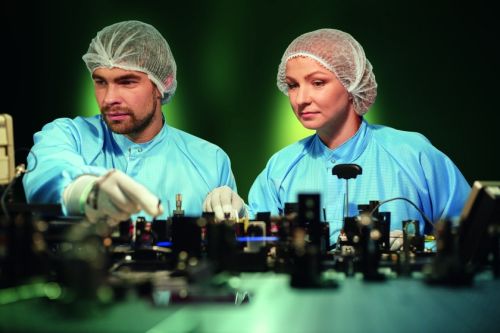
EKSPLA
EKPLA offers a wide range of femtosecond, picosecond and nanosecond lasers as well as tunable wavelength systems for research and industrial applications.

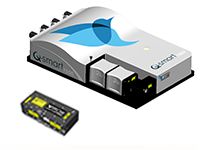
Lumibird
Lumibird nanosecond Q-switched Nd:YAG lasers are well known for their ruggeness and versatility. From 5 mJ to 1.5 J at 1064 nm, from single pulse to 400 Hz, they can be diode-pumped (compactness, ease of use) or flashlamp-pumped (high energy), and are available at 532 nm, 355 nm, 266 nm and 1.5 µm. Double pulse models are also proposed for applications in fluid mechanics (PIV).
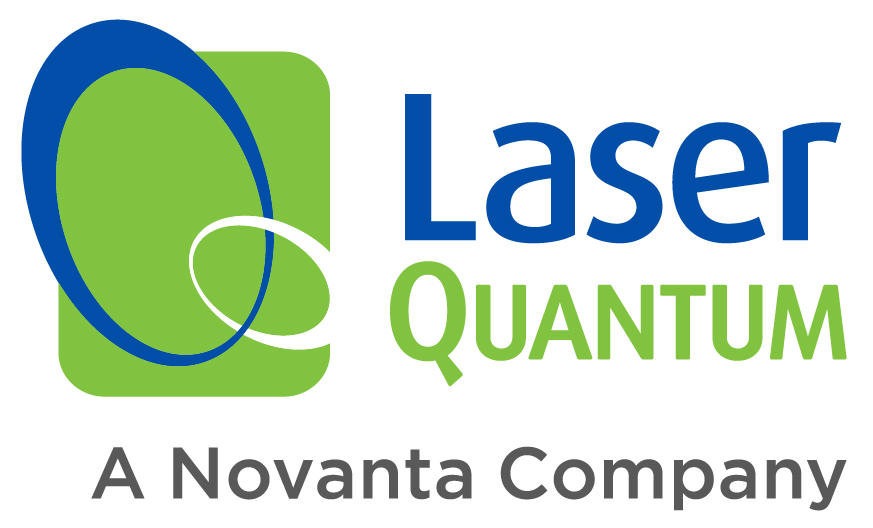

Laser Quantum
Laser Quantum is a world-class manufacturer of high-quality diode-pumped solid-state lasers and ultrafast lasers. Laser Quantum’s products are known for their reliability, compactness, performance-excellence and long operational lifetimes. Laser Quantum products can be found in laboratories and integrated into systems and machines worldwide, spanning a large variety of scientific applications.
Questions and Comments from Users
Here you can submit questions and comments. As far as they get accepted by the author, they will appear above this paragraph together with the author’s answer. The author will decide on acceptance based on certain criteria. Essentially, the issue must be of sufficiently broad interest.
Please do not enter personal data here; we would otherwise delete it soon. (See also our privacy declaration.) If you wish to receive personal feedback or consultancy from the author, please contact him e.g. via e-mail.
By submitting the information, you give your consent to the potential publication of your inputs on our website according to our rules. (If you later retract your consent, we will delete those inputs.) As your inputs are first reviewed by the author, they may be published with some delay.
Bibliography
| [1] | J. E. Geusic et al., “Laser oscillations in Nd-doped yttrium aluminum, yttrium gallium and gadolinium garnets”, Appl. Phys. Lett. 4 (10), 182 (1964), doi:10.1063/1.1753928 |
| [2] | D. Y. Shen et al., “Highly efficient in-band pumped Er:YAG laser with 60 W of output at 1645 nm”, Opt. Lett. 31 (6), 754 (2006), doi:10.1364/OL.31.000754 |
| [3] | J. W. Kim et al., “Fiber-laser-pumped Er:YAG lasers”, IEEE Sel. Top. Quantum Electron. 15 (2), 361 (2009), doi:10.1109/JSTQE.2009.2010248 |
| [4] | Li Chaoyang et al., “106.5 W high beam quality diode-side-pumped Nd:YAG laser at 1123 nm”, Opt. Express 18 (8), 7923 (2010), doi:10.1364/OE.18.007923 |
| [5] | X. Délen et al., “34 W continuous wave Nd:YAG single crystal fiber laser emitting at 946 nm”, Appl. Phys. B 104 (1), 1 (2011), doi:10.1007/s00340-011-4638-5 |
| [6] | H. C. Lee et al., “Diode-pumped continuous-wave eye-safe Nd:YAG laser at 1415 nm”, Opt. Lett. 37 (7), 1160 (2012), doi:10.1364/OL.37.001160 |
See also: vanadate lasers, YLF lasers, laser crystals, neodymium-doped gain media, chromium-doped gain media, ytterbium-doped gain media, rare-earth-doped gain media, ceramic gain media, solid-state lasers, lamp-pumped lasers, diode-pumped lasers, nonplanar ring oscillators, The Photonics Spotlight 2006-09-16
and other articles in the categories optical materials, lasers

This encyclopedia is authored by Dr. Rüdiger Paschotta, the founder and executive of RP Photonics Consulting GmbH. How about a tailored training course from this distinguished expert at your location? Contact RP Photonics to find out how his technical consulting services (e.g. product designs, problem solving, independent evaluations, training) and software could become very valuable for your business!
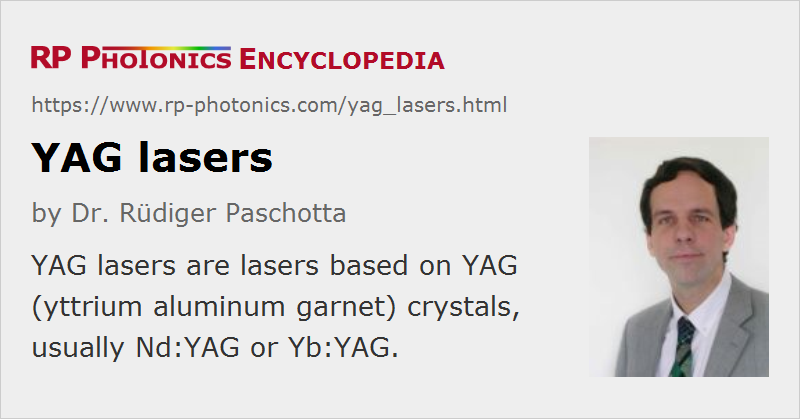 |



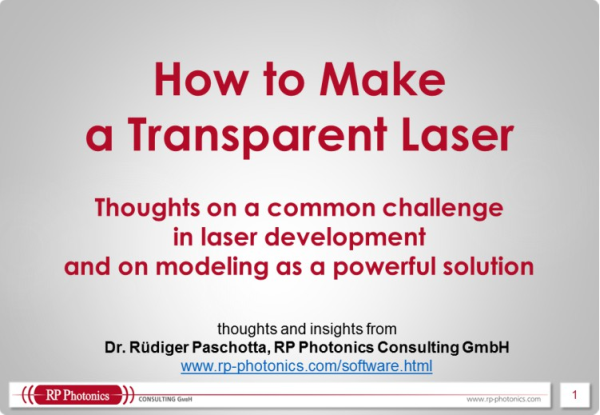
If you like this page, please share the link with your friends and colleagues, e.g. via social media:
These sharing buttons are implemented in a privacy-friendly way!